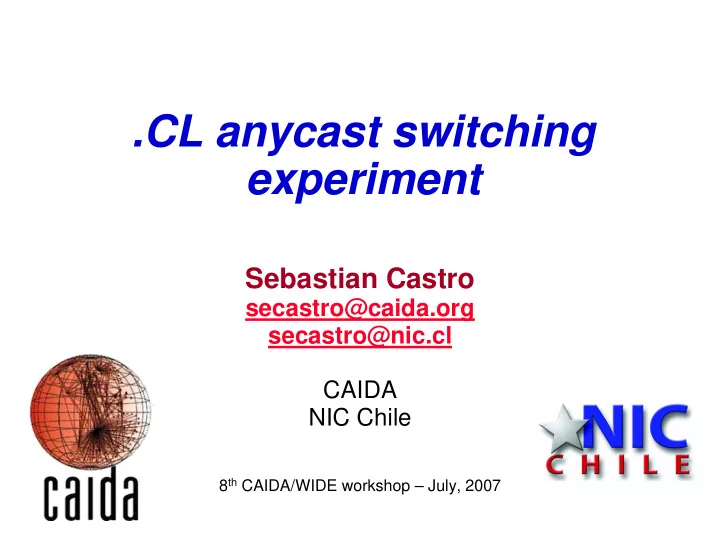

.CL anycast switching experiment Sebastian Castro secastro@caida.org secastro@nic.cl CAIDA NIC Chile 8 th CAIDA/WIDE workshop – July, 2007
Introduction • The anycast technology has been widely deployed in various DNS services around the world. – With the objective of provide improved reliability. • Several research has been conducted to get a deeper understanding of its behavior – Degrees of importance among different nodes (RIPE), geographic influence (CAIDA), etc. • Wanted to know how a client is affected when an anycast node is shut down – Time of no-service 2
.CL anycast deployment • One anycast cloud (a.nic.cl) with three nodes located in Chile – santiago, located in Santiago – valparaiso, located in Valparaiso, 150 km to the west of Santiago. – tucapel, located in Concepcion, 650 km to the south of Santiago. • Additionally one unicast server (ns.nic.cl) • 5 additional nameservers located around the world. 3
Methodology • 6-hour packet traces on every node (including the unicast server) • Shut down one node two hours after the beginning of the trace (withdrawing the BGP announcement) • Restore the node two hours after the shutdown (reinjecting the BGP prefix) • Nodes time-synchronized with NTP 4
The Experiments • Three different attempts • Taking one anycast node on each instance • First two were used as preparation – Didn’t work as expected by operator mistake • The third try took the busiest node down “ santiago ”. – On April 18 th , 2007. – From 11:00 to 17:00 CLT • 15:00 to 21:00 UTC • Packet traces included queries and responses, UDP and TCP. 5
Results • Query load – Within the cloud, santiago receives a biggest part of the load. – Within the country, the unicast server receives similar load of the anycast cloud. – An interesting spike at 13:40 CLT caught our attention 6
The spike • The spike was produced by a burst of MX queries. • Mainly coming from Chile, USA and Brasil. – Other countries also contributed. – The phenomenon lasted beyond the duration of the experiment. 7
Query load per source address Number of Query load Percentage of Queries per Queries per second unique sources [# of queries] total load address < 0.01 172 790 647 944 8.207 3.750 0.01 - 0.1 11 594 726 899 9.207 62.696 0.1 - 1 2 602 1 518 605 19.235 583.630 1 - 10 346 3 130 768 39.656 9 048.462 10 - 100 2 1 870 693 23.695 935 346.500 8 Total 187 334 7 894 909 100.000 42.143
Load redistribution % of load Before After Diff santiago 25.11 0 -25.11 ns 46.57 52.56 +5.99 valparaiso 4.54 13.38 +8.84 tucapel 23.77 34.03 +10.26 9
Geographic characterization • The number of clients per minute aggregated by country is relatively steady • The number of clients coming from USA to the anycast cloud is surprisingly high (considering there are other authoritative nameservers for .CL closer to those clients). 10
Geographic characterization • In terms of queries per second aggregated by country, we could see the traffic coming from Chile is clearly “unstable” compared to any other country. • Checking further on that, we found… 11
Spiky local load • Nine clients were primarily responsible for the high variation. • We plotted the clients with the highest standard deviation of the query rate. 12
Spiky local load • One client (200.31.36.65), sending the same query in bursts of 60 queries per second, during 20 seconds each 10 minutes. – IN, A, EXCH_STGO.viconto.cl • Four clients querying for the same pair of queries, probably due to a zone operator mistake. – IN, A, ns5.chileadmin.cl.imm.cl – IN, A, ns6.chileadmin.cl.imm.cl • One client sending MX queries, iterating over an alphabetic list of names (SPAM activities perhaps?) 13
Client switching • 7 894 909 total queries • 187 334 unique source addresses • 44 968 unique source addresses switched • 72 390 total switches san -> tuc -> val -> san val -> tuc san -> val tuc -> val tuc san One way switch 245 251 540 8586 42 9752 Two way switch 1720 47 5 129 84 24501 Reverse two way 5 84 1 720 24 501 47 129 switch Total 1 971 382 2 265 33 217 173 34 382 Percentage of queries generated by the 0.952 1.654 4.059 22.269 0.816 2.660 clients switching to: 14
Switching time • This graph represents the queries sent by the top 5 most prolific sources. The graph is focused on the moment of the shutdown of the node. 15
Switching time • Elapsed time: time Elapsed Switching IP Address Time Time between the shutdown and [s] [s] the last query seen on that node. 200.27.2.7 0.307 0.071 • Switching time: time between the last query 200.27.2.2 0.341 0.114 seen on the shutdown node and the first query 200.142.99.6 < 0 32.767 seen in any other member of the cloud from the same 201.238.238.102 0.355 < 0 client. 13.319 200.14.80.61 0.355 [0.039] 16
Conclusions • On query load graphs and shutdown graph, there is some evidence of clients leaving the cloud and querying somewhere else. That load shifts from the anycast to the unicast server, probably selected by a lower RTT. • The convergence time seen on this experiment is surprisingly short, if we think about the BGP updates convergence. The presence of the unicast server seems to be an added factor of stability. 17
Recommend
More recommend